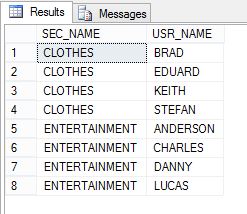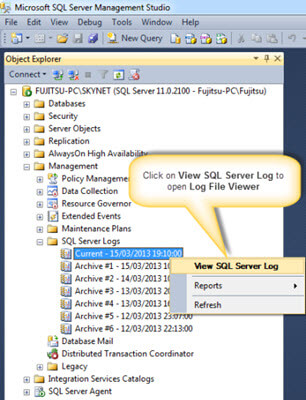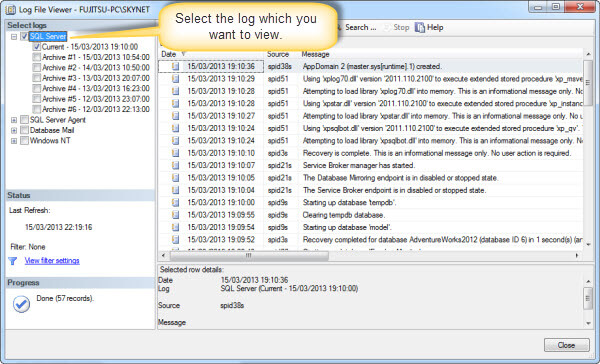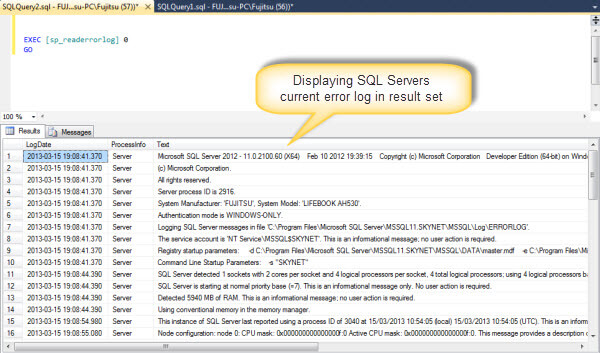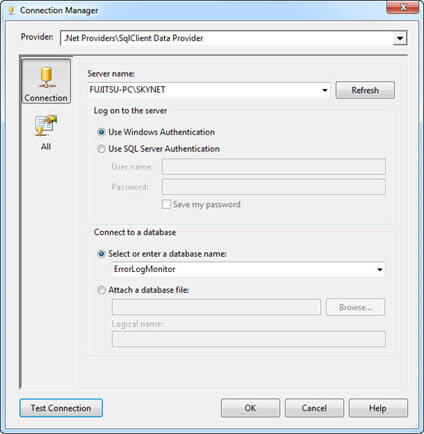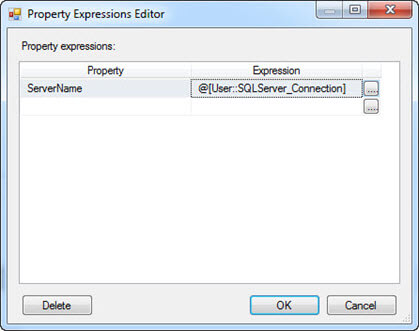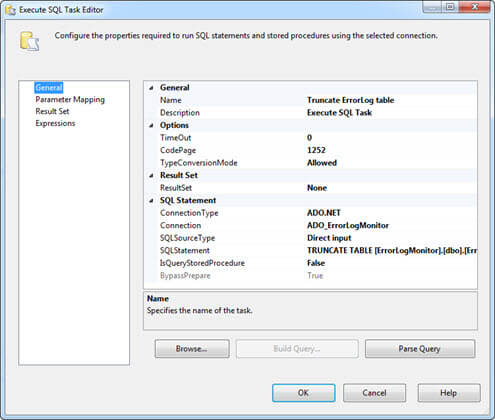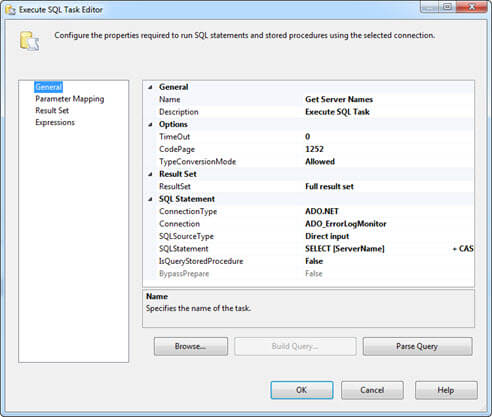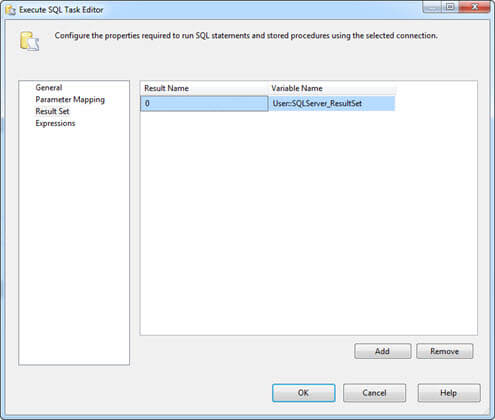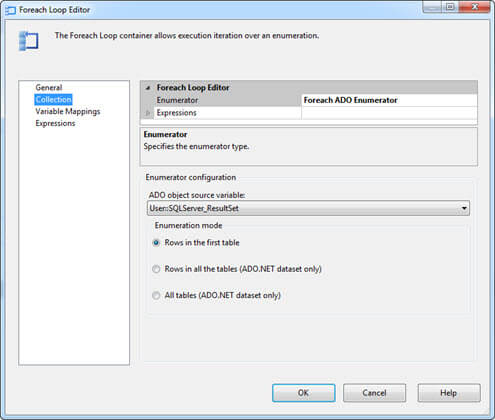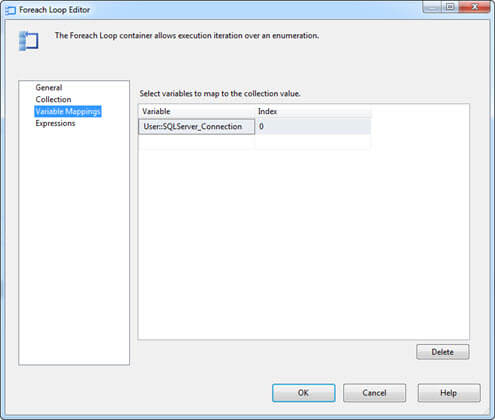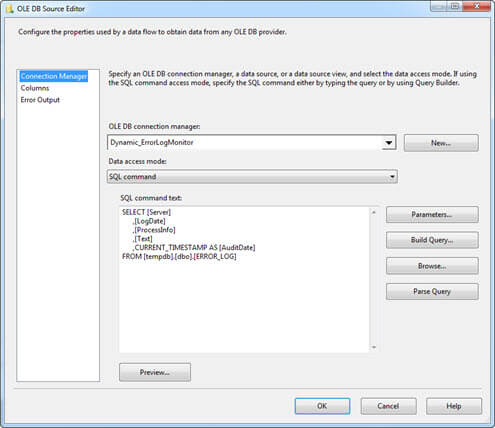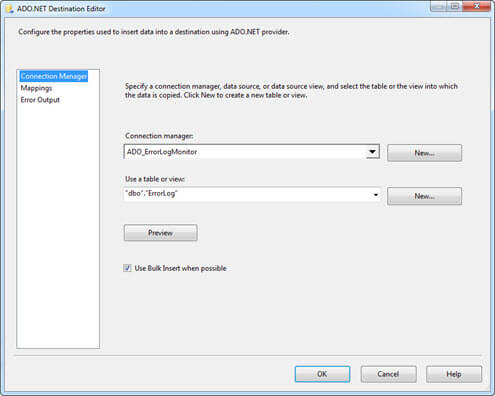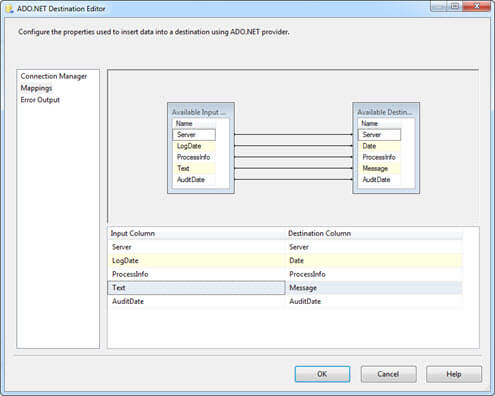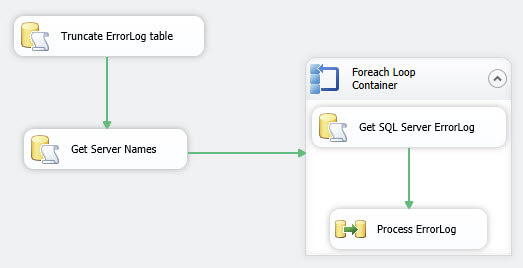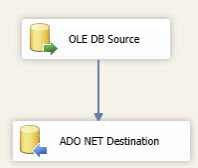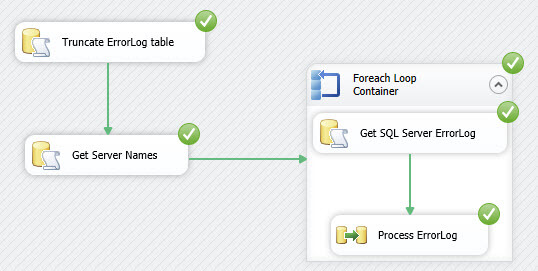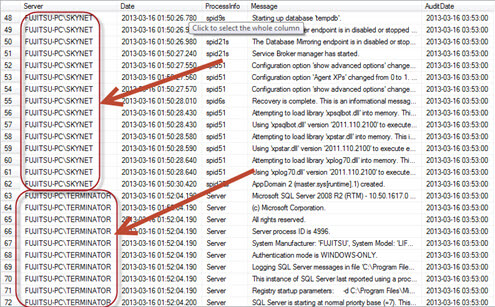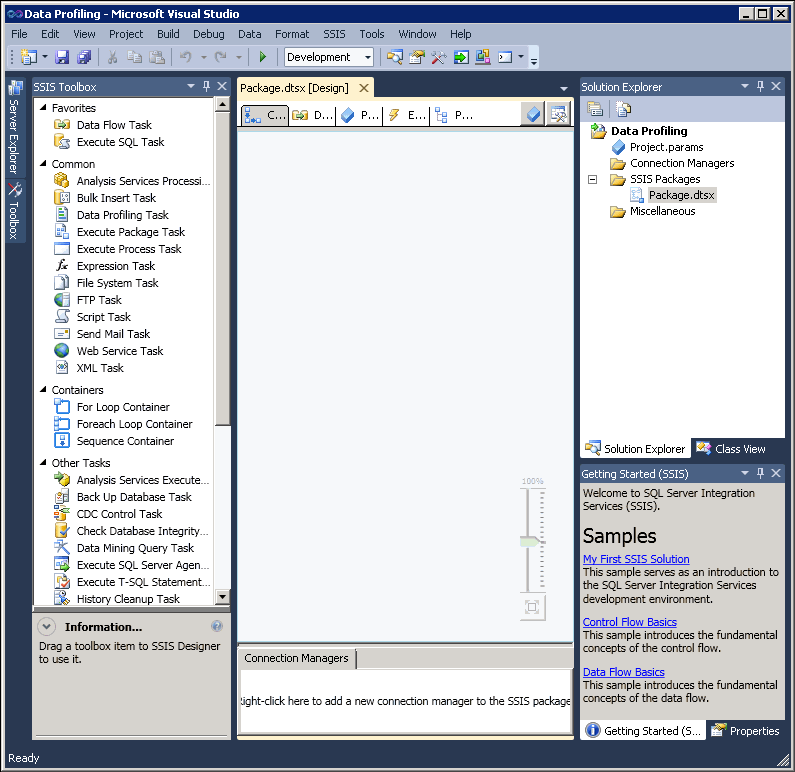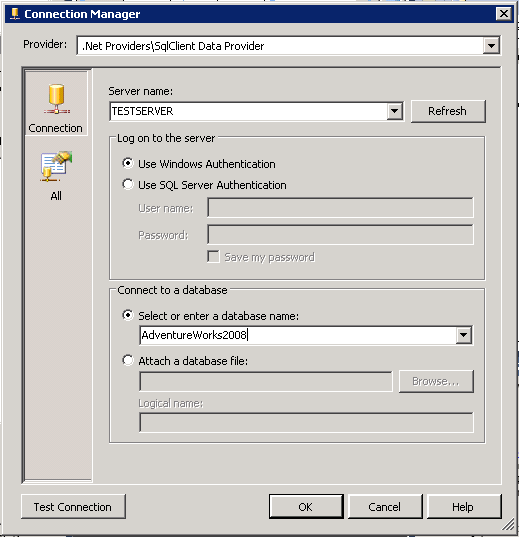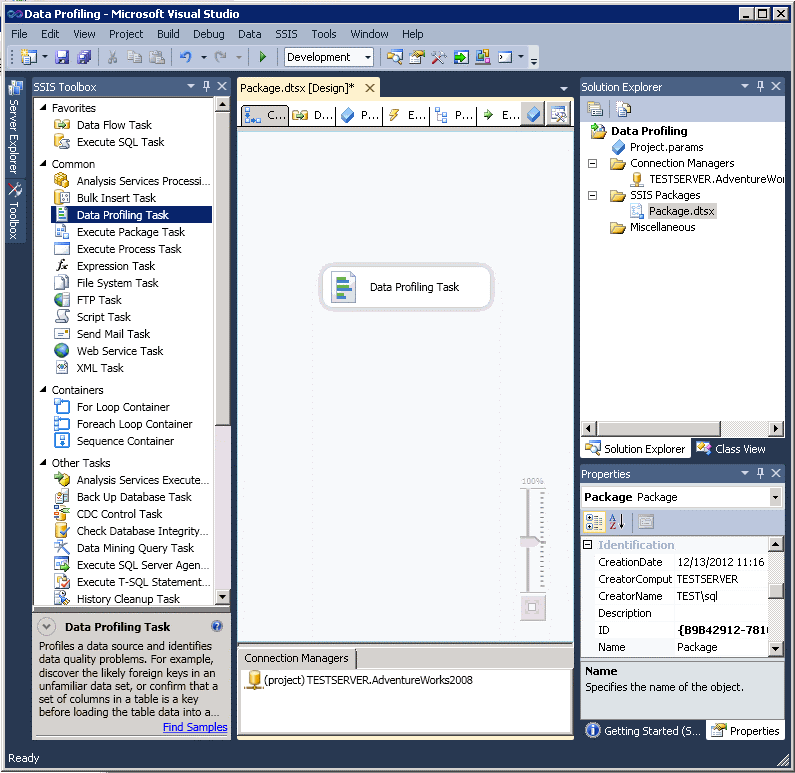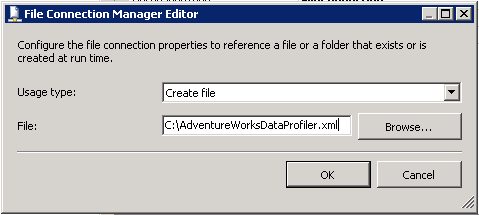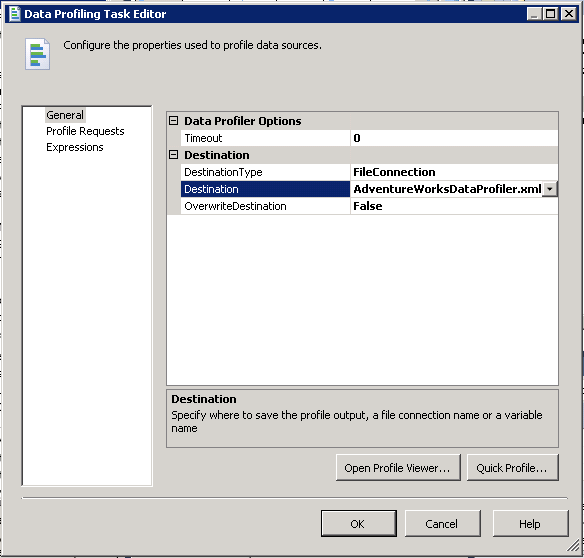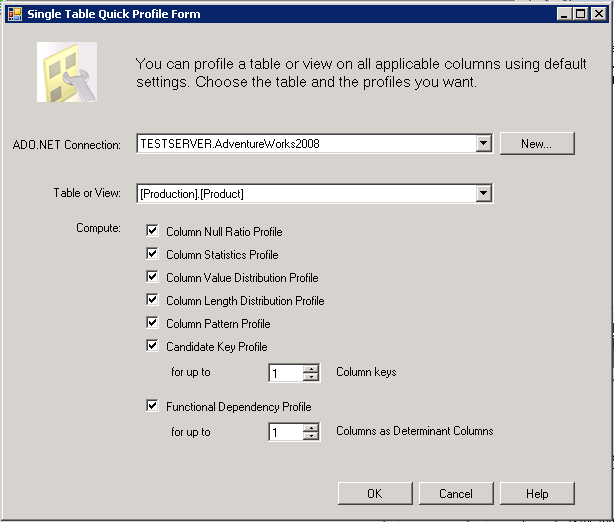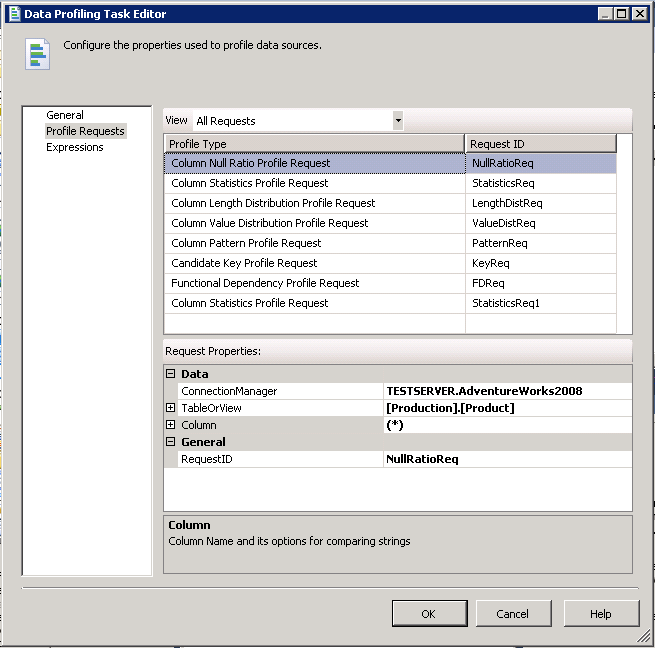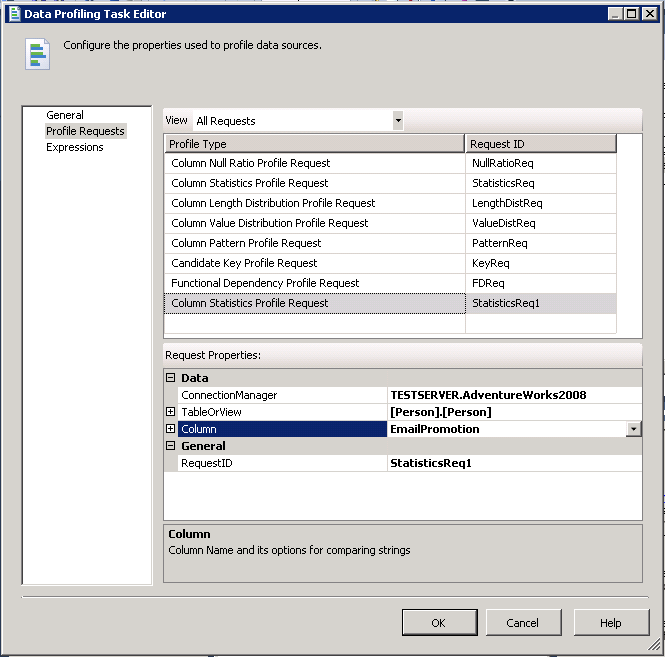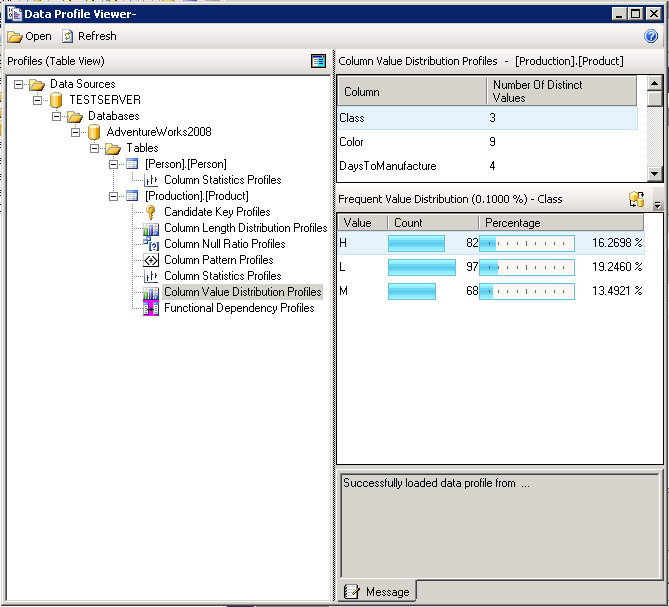Consolidating Error Logs from multiple SQL Servers using SSIS
Problem
SQL Server stores all informational messages, warning messages, and
errors in operating system and application log files. As a database
administrator (DBA), it is our responsibility to review the information
in the error log files on a daily basis for any errors that have
occurred in our SQL Server environment. However, manually reviewing the
log files daily is not an easy task in a busy SQL Server environment,
and it can quickly consume a large part of your day. Therefore, most
DBAs tend to skip this when they are busy with other production
problems. In this tip, I'll show you how we can consolidate error log
entries from multiple servers into a central location, and then report
on them from central location.
Solution
Before we talk about our custom solution for consolidating SQL error
log, I will first state the purpose of SQL Server error log and show
different ways for viewing it on SQL Server.
Purpose of SQL Server ErrorLog
SQL Server keeps logs for Database Mail, SQL Server (database server)
and SQL Server Agent (error log) in operating system and application
log files. SQL Server maintains a current log and archive logs. By
default, it keeps six archive logs. Only logins that are members of the
sysadmin and
securityadmin
fixed server role are able to view SQL Server logs.
Viewing SQL Server Logs Using SQL Server Management Studio
To open the Log File Viewer in Management Studio:
- Launch SQL Server Management Studio and then connect to a SQL Server
instance.
- In Object Explorer, expand Management, SQL Server Logs.
- Right-click the current log or an archive log and choose View SQL Server Log.
To open the Log File Viewer from the SQL Server Agent Error Logs:
- Expand SQL Server Agent, Error Logs.
- Right-click the current log or an archive log and choose View Agent Log.
Log File Viewer
The Log File Viewer is shown below:
The Select logs window lets you choose from:
- SQL Server
- SQL Server Agent
- Database Mail
- Windows logs
You can view the Windows Application and System log and with
sufficient permissions
the Security logs too. Log entry details display in the lower pane when
you select a log entry. Most of the messages in the SQL Server logs are
informational only and require no corrective action.
Viewing SQL Server Logs Using T-SQL
You can use
sp_readerrorlog that is an undocumented stored procedure to view SQL
Server error logs. It accepts log file number as a parameter. For
example, to view the current log file, execute the
sp_readerrorlog as follow:
EXEC [sp_readerrorlog] 0
GO
Solution for Consolidating SQL Server Logs
Now that we understand the purpose of SQL Server logs, let's begin
with our solution. This solution is built using SSIS, and will help you
consolidate and merge error logs from multiple SQL Servers.
For the purpose of this article, create a database called ErrorLogMonitor on
a SQL Server instance, where you want to consolidate the error logs.
Execute the following T-SQL script to create this database:
CREATE DATABASE [ErrorLogMonitor]
ON PRIMARY
( NAME = N'ErrorLogMonitor'
, FILENAME = N'\ErrorLogMonitor.mdf'
, SIZE = 4160KB , MAXSIZE = UNLIMITED, FILEGROWTH = 1024KB )
LOG ON
( NAME = N'ErrorLogMonitor_log'
, FILENAME = N'\ErrorLogMonitor_log.ldf'
, SIZE = 1040KB , MAXSIZE = 2048GB , FILEGROWTH = 10%)
GO
Next, create the following two tables inside this database:
- SSISServersList– The table stores the names of each SQL Server for which you want to read SQL Server error log.
- ErrorLog– The table will store the error log data for all
of the SQL Servers you are monitoring.
To create the tables, execute the following:
USE [ErrorLogMonitor]
GO
CREATE TABLE [dbo].[SSISServersList](
[ServerName] [nvarchar](128) NOT NULL,
[IsTest] [bit] NULL,
[Active] [bit] NULL,
[Port] [int] NULL) ON [PRIMARY]
GO
CREATE TABLE [dbo].[ErrorLog](
[Server] [nvarchar](128) NOT NULL,
[Date] [datetime] NULL,
[ProcessInfo] [varchar](50) NULL,
[Message] [nvarchar](4000) NULL,
[AuditDate] [smalldatetime] NOT NULL,
[LoadID] [int] NOT NULL
) ON [PRIMARY]
GO
Finally, we are ready to design our SSIS package. To do that launch SQL Server Data tools and create
a new Integration Services project. Once the package is created, it will create
an empty package. Rename this package to
ConsolidateErrorLog_Package.dtsx.
Follow these steps to configure the package.
1: Defining Package Variables
Add the following two variables for the SSIS package:
-
Variable 1: SQLServer_Connection
- Scope: ConsolidateErrorLog_Package
- Data Type: String
- Value:<You SQL Server instance name> (Specify the instance name where ErrorLogMonitor database is located).
-
Variable 2: SQLServer_ResultSet
- Scope: ConsolidateErrorLog_Package
- Data Type: Object
- Value: System.Object
To do that, right-click anywhere on the empty panel on the Control
Flow Tab, then select Variables and then click Add Variables icon (see
below).
2: Defining Package Connections
First create a new ADO.NET connection to the ErrorLogMonitor database
on your SQL Server. To do this, click anywhere on the Connection
Managers, and choose New ADO.NET Connection. Configure the ADO.NET
connection as follow:
Rename the connection to ADO_ErrorLogMonitor.
Next, create the dynamic OLE-DB connection, this connection allows us
to connect to the different SQL Server instances. This connection is
passed with SQLServer_Connection variable that contains SQL Server
instance name from the SSISServerList table, which
was created earlier. Rename the connection to Dynamic_ErrorLogMonitor.
Now right-click the Dynamic_ErrorLogMonitor connection and then
choose Properties.
First change the initial catalog to master, and then click (…) box next
to expression and specify the following expression for ServerName
property:
@[User::SQLServer_Connection]
3: Defining Package Tasks
3.1: Configuring “Truncate ErrorLog table” – Execute SQL Task
Add an “Execute SQL Task” to the control flow. Double-click the task and configure properties in
the “General” page of the task as follows:
- Rename “Execute SQL Task” to “Get SQL Server ErrorLog”.
- Set “ResultSet” property to “None”.
- Set “Connection Type” property to “ADO.NET”.
- Set “Connection” property to “ADO_ErrorLogMonitor”.
- Set “BypassPrepare” to “True”.
- Set “SQLStatement” property with the error log collection script below:
TRUNCATE TABLE [dbo].[ErrorLog]
3.2: Configuring “Get Server Names” – Execute SQL Task
Add “Execute SQL Task” to control flow. Double-click the task and configure properties in
the “General” page of the task as follows:
- Rename “Execute SQL Task” to “Get SQL Server Names”.
- Set “ResultSet” property to “Full result set”.
- Set “Connection Type” property to “ADO.NET”.
- Set “Connection” property to “ADO_ErrorLogMonitor”.
- Set “BypassPrepare” to “False”.
- Set “SQLStatement” to the following:
SELECT [ServerName]
+ CASE ISNULL(CAST([Port] AS [varchar](10)), '')
WHEN ''
THEN ''
ELSE ',' + CAST([Port] AS [varchar](10))
END AS [ServerName]
FROM [dbo].[SSISServersList]
WHERE [Active] = 1
GO
Click ResultSet in left pane and then click Add to add the "User::SQLServer_ResultSet" variable
as shown below. Change Result Name value to 0, and then click OK to save the configuration for the task.
Then in the SSIS package, connect the “Truncate ErrorLog table” task to the “Get Server Names” task.
3.3: Configuring – ForEach loop container
Drag and drop a ForEach loop container to the package control flow.
Double-click the ForEach loop container, and then click Collection
in left pane. Here configure the properties of this window as follows:
- Change “Enumerator” property to “Foreach ADO Enumerator”.
- Set “Enumeration Mode” to “Rows in the first table”.
- Specify “ADO object source variable” to the “User::SQLServer_ResultSet” package variable.
Now click “Variable Mappings” and select “User::SQLServer_Connection” package variable to map to the collection value.
Then in the SSIS package, connect the “Get Server Names” task with the “ForEach loop” container.
3.4: Configuring “Get SQL Server ErrorLog” – Execute SQL Task
Add an “Execute SQL Task” inside the ForEach loop container. Double-click the task and configure properties in
the “General” page of the task as follows:
- Rename “Execute SQL Task” to “Get SQL Server ErrorLog”.
- Set “ResultSet” property to “None”.
- Set “Connection Type” property to “OLE DB”.
- Set “Connection” property to “Dynamic_ErrorLogMonitor”.
- Set “BypassPrepare” to “True”.
- Set “SQLStatement” property with the error log collection script below:
SET NOCOUNT ON;
SET DATEFORMAT MDY;
DECLARE @LoadID [int]
,@FileNumber [tinyint]
,@ErrorLogSize [bigint]
,@ExtractDate [datetime]
,@SQLServer [nvarchar](128)
IF NOT EXISTS (SELECT * FROM [tempdb].[sys].[objects]
WHERE [name] = 'ERROR_LOG' AND [type] IN (N'U'))
BEGIN
CREATE TABLE [tempdb].[dbo].[ERROR_LOG]
([Server] [nvarchar](128) NULL
,[LogDate] [datetime] NULL
,[ProcessInfo] [varchar](50) NULL
,[Text] [nvarchar](4000) NULL)
END
ELSE
BEGIN
TRUNCATE TABLE [tempdb].[dbo].[ERROR_LOG]
END
IF OBJECT_ID('tempdb..#ErrorLogs') IS NOT NULL
DROP TABLE #ErrorLogs
CREATE TABLE #ErrorLogs
([ArchiveNumber] [int]
,[DateLastChanged] [datetime] NOT NULL
,[LogFileSizeInBytes] [bigint])
-- Reading the error logs files details
INSERT INTO #ErrorLogs
EXEC [master]..[xp_enumerrorlogs]
-- Assigning values to variables
SELECT @FileNumber = [ArchiveNumber]
,@ErrorLogSize = [LogFileSizeInBytes]
FROM #ErrorLogs
WHERE [ArchiveNumber] = 0
-- Set extract date for 1 day
SET @ExtractDate = DATEADD(dd, -1, CURRENT_TIMESTAMP)
IF (@ErrorLogSize <= 536870912)
BEGIN
-- Loading the latest errorlog information inside table
INSERT INTO [tempdb].[dbo].[ERROR_LOG]
([LogDate]
,[ProcessInfo]
,[Text])
EXEC [sp_readerrorlog] 0
END
ELSE
BEGIN
INSERT INTO [tempdb].[dbo].[ERROR_LOG]
([LogDate]
,[ProcessInfo]
,[Text])
VALUES (CURRENT_TIMESTAMP
,'Server'
,'ErrorLog is two big to load.')
END
DELETE FROM [tempdb].[dbo].[ERROR_LOG]
WHERE [LogDate] < @ExtractDate
DELETE FROM [tempdb].[dbo].[ERROR_LOG]
WHERE [ProcessInfo] = 'Backup'
DELETE FROM [tempdb].[dbo].[ERROR_LOG]
WHERE [ProcessInfo] = 'Logon'
UPDATE [tempdb].[dbo].[ERROR_LOG]
SET [Server] = CAST(SERVERPROPERTY('ServerName') AS [nvarchar](128))
SET NOCOUNT OFF;
GO
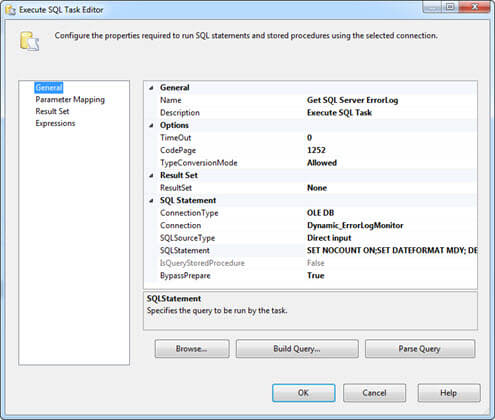
3.5: Configuring “Process ErrorLog” – Data Flow Task
Add a “Data Flow Task” inside the ForEach loop container and rename it to “Process ErrorLog”. Connect
the “Data Flow Task” with the “Get SQL Server ErrorLog”.
Now, double-click the “Data Flow Task”, and drag the “OLE DB Source”
and “ADO NET Destination” to the “Data Flow Task”. Next, connect
the “OLE DB Source” with the “ADO NET Destination. Then double-click
“OLE DB Source” and specify
the settings as follows:
- Set “OLE DB Connection Manager” to “Dynamic_ErrorLogMonitor”.
- Change “Data access mode” to “SQL command”
- Specify the following query in “SQL command text”:
SELECT [Server]
,[LogDate]
,[ProcessInfo]
,[Text]
,CURRENT_TIMESTAMP AS [AuditDate]
FROM [tempdb].[dbo].[ERROR_LOG]
GO
Once done, click OK to save the settings and return to Data Flow.
Finally, double-click “ADO NET Destination” and configure as follow:
- Set “Connection manager” to “ADO_ErrorLogMonitor”.
- Select “dbo.ErrorLog” table in our “ErrorLogMonitor” database, where data will be copied.
- Then map source table to destination table.
Click OK to save settings.
Package Review
All done, our package is fully configured, and it is now ready for us
to execute the package. The package control flow and data flow look
similar to the following figures:
Control Flow - ConsolidateErrorLog_Package.dtsx
Data Flow - ConsolidateErrorLog_Package.dtsx
Testing
To test the package, simply add a few servers in the SSISServerList table and then execute the package using
the play button in SQL Server Data Tools (see below):
Once successfully executed, query the data of dbo.ErrorLog inside our
ErrorLogMonitor database to retrieve all SQL servers error logs (see
below):
Next Steps
-
Download this SSIS solution
- No matter how well you have
designed and tested a database, errors will occur. You can use SQL
Server error log files to view information about errors that have
occurred because SQL Server stores all informational messages, warning
messages, and errors in operating system and application log files.
- Take the next steps and write some queries that can then pull key errors
from this consolidated table.
- Create a job that finds key errors and
sends you emails notifications.
- Check out these related tips:
THANK YOU & Visit Again (Give me your precious comments/queries)
ready to help.
 Next, I will right click and edit and choose my connection and SQLStatement:
Next, I will right click and edit and choose my connection and SQLStatement: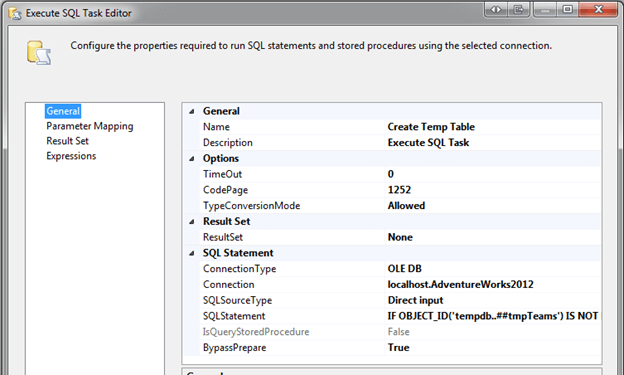 (The SQL statement used in this example is below)
Next, I will drag a Data Flow task into my Design view, rename it Query and drag the precedence constraint between the two:
(The SQL statement used in this example is below)
Next, I will drag a Data Flow task into my Design view, rename it Query and drag the precedence constraint between the two: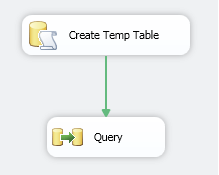 For the Data Flow task we are going to query the temp table and
export the results to a database table. Right click the Data Flow task
and choose Edit. Drag a OLE DB Source and a OLE DB Destination task into
the Design view.
For the Data Flow task we are going to query the temp table and
export the results to a database table. Right click the Data Flow task
and choose Edit. Drag a OLE DB Source and a OLE DB Destination task into
the Design view.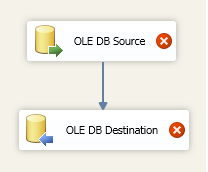 To avoid errors when configuring the OLE DB Source we need to create
the temp table first using SSMS. In SSMS run the following statement to
create a global temp table:
To avoid errors when configuring the OLE DB Source we need to create
the temp table first using SSMS. In SSMS run the following statement to
create a global temp table: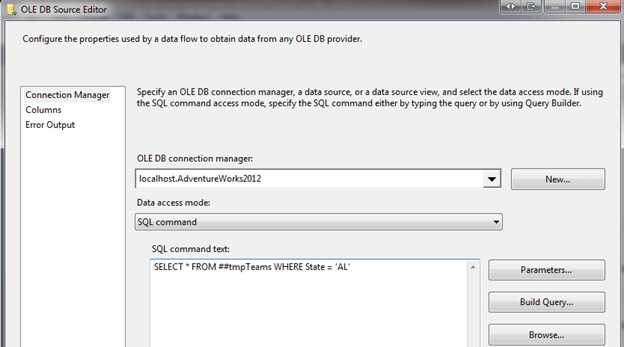 Hit OK on the OLE DB Source window and right click OLE DB Destination
and choose Edit. Choose your datasource and choose "Table or View –
fast load" from the Data access mode dropdown. I already created a table
called AlabamaTeams that I will use to display the data and will use
this name in the dropdown for the Name of the table or the view.
Hit OK on the OLE DB Source window and right click OLE DB Destination
and choose Edit. Choose your datasource and choose "Table or View –
fast load" from the Data access mode dropdown. I already created a table
called AlabamaTeams that I will use to display the data and will use
this name in the dropdown for the Name of the table or the view.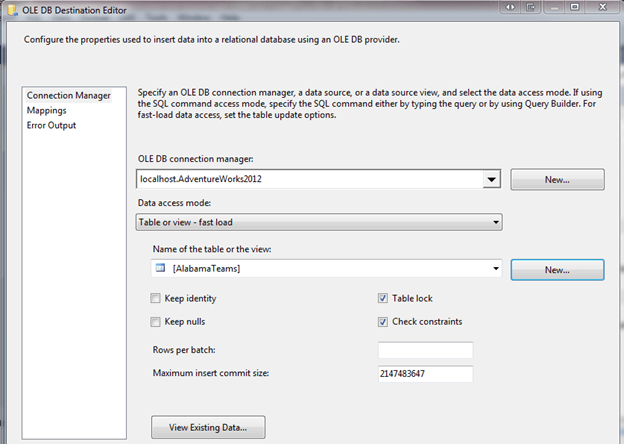 Once finished configuring the OLE DB Destination hit OK. We are now
ready to execute the package. Hit F5 to begin or choose Debug, Start
Debugging from the Menu bar:
Once finished configuring the OLE DB Destination hit OK. We are now
ready to execute the package. Hit F5 to begin or choose Debug, Start
Debugging from the Menu bar: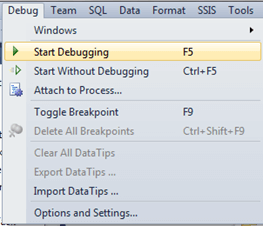 After executing the package, an error will occur on the Query task:
After executing the package, an error will occur on the Query task: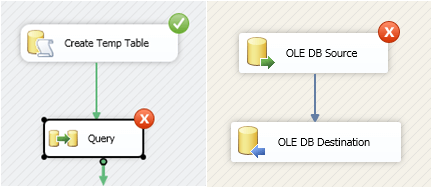 If we look at the Progress tab we can see that the reason this error
occurs is because after the temp table is created in the “Create Temp
Table” task it is deleted. The “Query” task searches for the table but
can’t find it.
If we look at the Progress tab we can see that the reason this error
occurs is because after the temp table is created in the “Create Temp
Table” task it is deleted. The “Query” task searches for the table but
can’t find it.
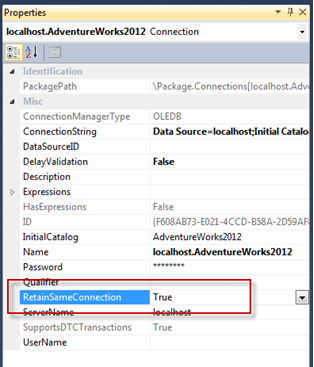 The second property we must change is the Execute SQL Task property.
If you right click on each task (Create Temp Table and Query) and choose
properties you will see a property called DelayValidation. This must be
set to “True”. DelayValidation means that the task will not check if
the table exists upon creation.
The second property we must change is the Execute SQL Task property.
If you right click on each task (Create Temp Table and Query) and choose
properties you will see a property called DelayValidation. This must be
set to “True”. DelayValidation means that the task will not check if
the table exists upon creation.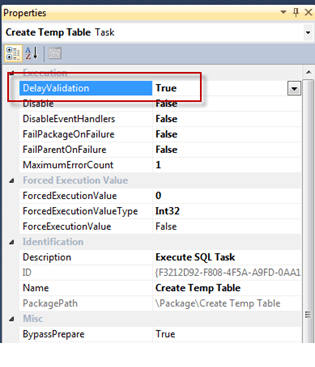 Once we have set both properties to “True”, execute the package again. The package should be successful this time:
Once we have set both properties to “True”, execute the package again. The package should be successful this time: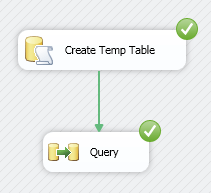 If we switch back over to SSMS and query the table, AlabamaTeams, we should return a result set:
If we switch back over to SSMS and query the table, AlabamaTeams, we should return a result set: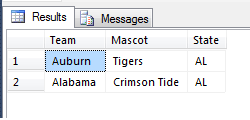 **Note: I’m using global temp tables (##tmpTeams) instead of local
temp tables (#tmpTeams) because when I create the table using SSMS the
first time it uses a different session (SPID) therefore when I try to
configure my OLE DB Source it cannot find the temp table and gives the
following error:
**Note: I’m using global temp tables (##tmpTeams) instead of local
temp tables (#tmpTeams) because when I create the table using SSMS the
first time it uses a different session (SPID) therefore when I try to
configure my OLE DB Source it cannot find the temp table and gives the
following error: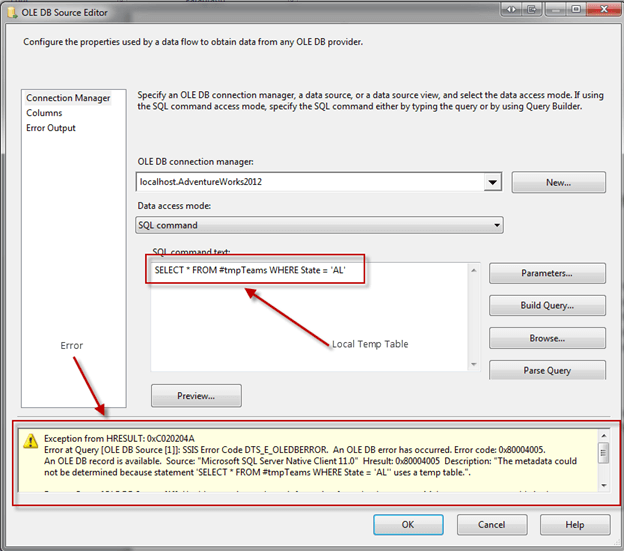 With that said, only global temp tables should be used. Also, make
sure when you are creating your global temp tables that the table name
does not interfere with any other global temp tables that may be created
using other processes.
With that said, only global temp tables should be used. Also, make
sure when you are creating your global temp tables that the table name
does not interfere with any other global temp tables that may be created
using other processes.
 (The SQL statement used in this example is below)
(The SQL statement used in this example is below)











